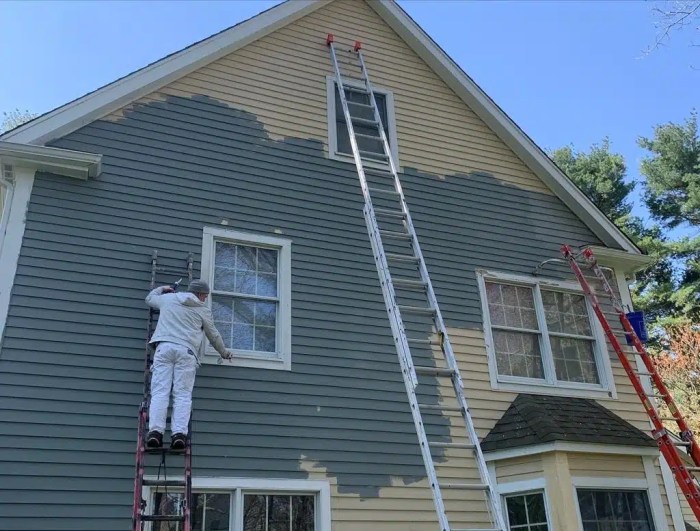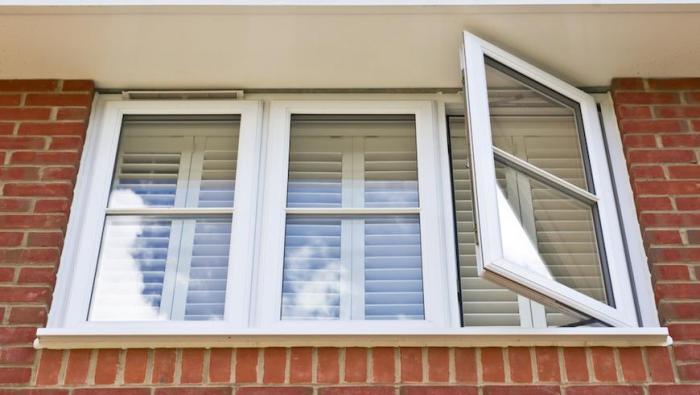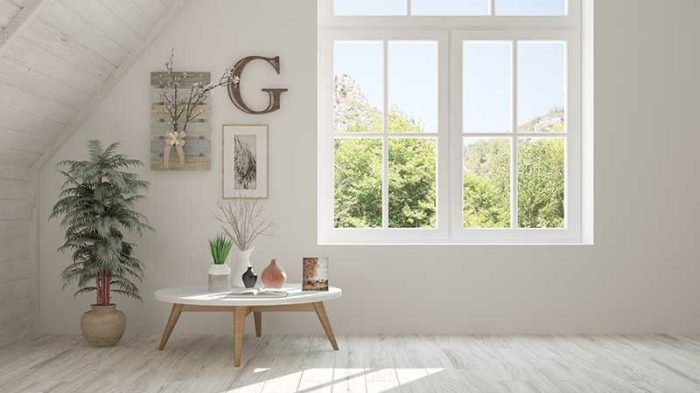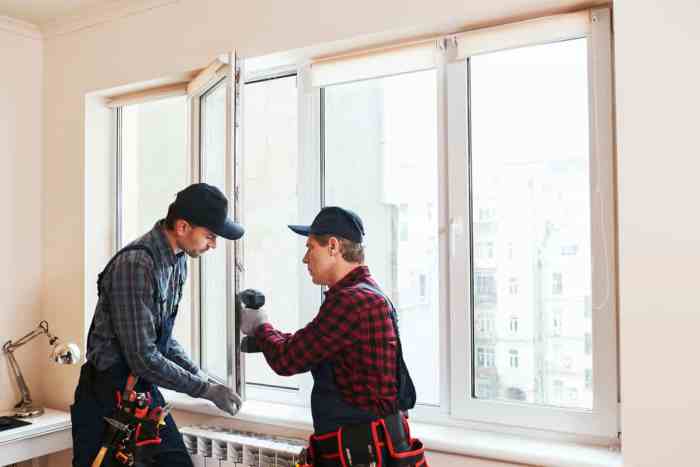Exterior Waterproofing A Comprehensive Guide
Exterior waterproofing is crucial for the longevity and structural integrity of any building, from humble homes to towering skyscrapers. Understanding the various methods, materials, and design considerations is key to effectively protecting your structure from water damage. This guide delves into the intricacies of exterior waterproofing, offering insights into historical context, different types of systems, and best practices for installation and maintenance.
From selecting the right waterproofing membrane to ensuring proper drainage and ventilation, this guide covers every aspect of exterior waterproofing. We’ll explore the properties of various materials, the step-by-step installation procedures, and the crucial design considerations that influence long-term performance.
Introduction to Exterior Waterproofing
Exterior waterproofing is a crucial aspect of building construction, encompassing the techniques and materials used to protect the exterior of structures from water damage. This protection safeguards the structural integrity, longevity, and aesthetic appeal of buildings across various types and applications. Effective waterproofing prevents moisture penetration, mitigating issues like rot, mold, and structural weakening.
Exterior waterproofing is vital for a multitude of building types, from residential homes to commercial skyscrapers and industrial facilities. Proper waterproofing systems are essential for preventing costly repairs and ensuring the long-term stability of the building. The effectiveness of exterior waterproofing directly impacts the building’s lifespan and overall value.
Historical Context of Exterior Waterproofing Techniques
Early waterproofing methods relied on readily available materials like clay, bitumen, and natural resins. These rudimentary techniques, while effective in some cases, often lacked durability and resilience to environmental factors. Over time, advancements in material science and construction technologies led to the development of more sophisticated waterproofing systems. The evolution of modern materials, like synthetic membranes and specialized coatings, has significantly improved the performance and longevity of exterior waterproofing.
Various Types of Exterior Waterproofing Systems
Exterior waterproofing systems are diverse and encompass a range of materials and application methods. These systems are tailored to specific building types, architectural designs, and environmental conditions. Different systems may employ various techniques, including membranes, coatings, and damp-proofing solutions.
Comparison of Waterproofing Materials
| Material | Properties | Applications | Pros/Cons |
|---|---|---|---|
| Bitumen-based Membranes | Durable, flexible, relatively inexpensive, and good adhesion to substrates. | Roofs, walls, and basements, particularly in older buildings or areas with simpler construction methods. | Can be brittle in cold temperatures, susceptible to UV degradation, potential for environmental contamination if not properly managed. |
| Polymer-modified Bitumen Membranes | Improved flexibility and durability compared to traditional bitumen, good adhesion, relatively resistant to UV. | Roofing, waterproofing around windows and doors, and other exterior applications. | Higher cost than traditional bitumen, and some environmental concerns related to specific polymers. |
| Elastomeric Coatings | Highly flexible, resistant to cracking, and long-lasting, good for areas exposed to movement or stress. | Walls, roofs, and other exterior surfaces. | Requires skilled application, can be susceptible to damage from extreme temperatures. |
| Spray Polyurethane Foam (SPF) | Excellent insulation properties, waterproof, and creates a seamless barrier. | Roofs, walls, and joints, particularly for new construction or retrofitting. | Expensive, requires specialized application equipment and expertise. |
| Liquid Applied Waterproofing Systems | Variety of chemistries, good for retrofitting, and can be applied to a wide range of surfaces. | Roofs, balconies, terraces, and other exterior areas. | Application can be complex and time-consuming, requires skilled labor, and certain chemistries may have environmental implications. |
Methods and Techniques

Source: icyreno.ca
Exterior waterproofing employs diverse methods and techniques, each tailored to specific building materials and conditions. Proper selection and execution are crucial for long-term protection against water damage. Careful consideration of factors like climate, substrate type, and budget is essential in choosing the optimal waterproofing solution.
Effective exterior waterproofing hinges on meticulous execution of chosen methods and techniques. Understanding the procedures for each method, from initial preparation to final finishing, is paramount for achieving lasting water resistance. This section details various waterproofing methods, outlining their procedures and comparing their efficacy, along with best practices for optimal results.
Membrane Systems
Membrane systems are a prevalent approach for exterior waterproofing, offering a continuous barrier against water infiltration. Different types of membranes, like modified bitumen, EPDM, or TPO, are available, each with unique properties and applications. These systems often involve multiple layers and precise installation techniques to ensure watertightness.
| Step | Description | Materials | Image Description |
|---|---|---|---|
| Step 1 | Thorough surface preparation is crucial. Remove loose debris, contaminants, and any existing coatings. Ensure the substrate is clean, dry, and properly leveled. | Scrapers, brushes, cleaning solutions, and primer | A close-up view of a surface being cleaned and prepared, showing the removal of loose materials and debris. |
| Step 2 | Apply a primer to the prepared substrate to enhance adhesion and promote bonding with the membrane. Allow the primer to dry completely according to the manufacturer’s instructions. | Primer, brushes or rollers, and safety equipment | A wide shot of the installation process in progress, showing the application of primer to the prepared substrate. |
| Step 3 | Lay the membrane material according to the manufacturer’s specifications. Ensure proper overlap and sealing at joints. Use specialized tools for accurate placement and tensioning. | Membrane sheets, adhesive, sealant, specialized tools like torches or welding equipment (depending on membrane type), safety equipment | A close-up view of membrane sheets being laid and overlapped, showing the careful alignment and sealing of joints. |
| Step 4 | Seal all joints and penetrations to prevent water from entering. Use appropriate sealants and tapes for various materials. | Sealants, tapes, caulking guns, and safety equipment | A wide shot of the installation process, showing the sealing of joints and penetrations. |
| Step 5 | Inspect the finished installation to ensure no gaps or imperfections. Perform quality control checks and address any issues promptly. | Inspection tools, sealant, and safety equipment | A close-up view of a finished waterproofing membrane, ensuring proper installation and absence of gaps or imperfections. |
Comparison of Installation Techniques
Different membrane systems necessitate specific installation techniques. Modified bitumen membranes often involve hot-air welding or torch application, while other types, such as EPDM, utilize adhesive bonding. Choosing the correct technique is vital for ensuring the longevity and effectiveness of the waterproofing system. The selection depends on factors like substrate type, environmental conditions, and aesthetic requirements.
Best Practices for Exterior Waterproofing
Thorough planning, meticulous preparation, and adhering to the manufacturer’s instructions are key elements of successful exterior waterproofing. Proper material selection, considering local climate conditions, is essential for long-term performance. Regular inspections and maintenance are also crucial to ensure the system’s integrity over time. Implementing preventative measures against potential issues, such as roof leaks, foundation cracks, and drainage problems, can contribute to the longevity of exterior waterproofing.
Materials and Components
Exterior waterproofing systems rely on a diverse range of materials and components to effectively protect structures from water damage. Careful selection and proper installation of these elements are crucial for long-term performance and structural integrity. The choice of materials is often dictated by the specific building type, climate conditions, and budget constraints.
A comprehensive understanding of the properties and characteristics of each material, coupled with an appreciation of the various components in a waterproofing system, allows for informed decision-making during the design and construction phases.
Common Waterproofing Materials
Various materials are employed in exterior waterproofing systems, each possessing unique strengths and weaknesses. These materials are often combined to create a robust and durable barrier against water penetration.
| Material | Strengths | Weaknesses | Applications |
|---|---|---|---|
| Bituminous Membranes | Excellent waterproofing properties, good adhesion to various substrates, and relatively easy to install. | Susceptible to UV degradation, can be brittle in cold temperatures, may require specialized installation techniques for complex shapes. | Roofs, walls, basements, and other areas prone to water intrusion. |
| Elastomeric Coatings | High elasticity, excellent resistance to cracking and stretching, durable and long-lasting, available in various colors and textures. | Can be expensive, may require specialized application equipment, potential for surface imperfections if not applied correctly. | Walls, roofs, and other exterior surfaces requiring a flexible and durable waterproofing solution. |
| Polyurethane Membranes | Highly durable, excellent chemical resistance, exceptional tensile strength, and long lifespan. | It can be challenging to install, potentially higher cost compared to other options, and may require specialized application equipment. | High-performance waterproofing applications in demanding environments, such as industrial facilities or high-traffic areas. |
| Polymer-Modified Concrete | Excellent durability and longevity, cost-effective, and environmentally friendly. | May require additional layers for complete waterproofing, needs proper curing for optimal performance, may not be suitable for extremely aggressive environments. | Foundations, pavements, and other concrete structures require a durable waterproofing layer. |
Components of a Typical Exterior Waterproofing System
A well-designed exterior waterproofing system comprises various components working in concert. Each component plays a vital role in preventing water intrusion and ensuring the longevity of the structure.
| Component | Function | Material | Importance |
|---|---|---|---|
| Primer | Prepares the substrate for better adhesion of the waterproofing membrane. | Various polymers and solvents | Crucial for achieving a strong bond between the waterproofing membrane and the surface, preventing water leakage. |
| Waterproofing Membrane | Forms a barrier against water penetration. | Bituminous, elastomeric, or polyurethane | The primary component is responsible for preventing water from seeping into the structure. |
| Flashing | Protects vulnerable areas, like joints and penetrations. | Metal, polymer | Essential in preventing water intrusion at critical points, ensuring complete waterproofing. |
| Drainage System | Facilitates the removal of water from the structure. | Gravel, pipes, gutters | Vital for diverting water away from the building, preventing water accumulation, and potential damage. |
Design Considerations
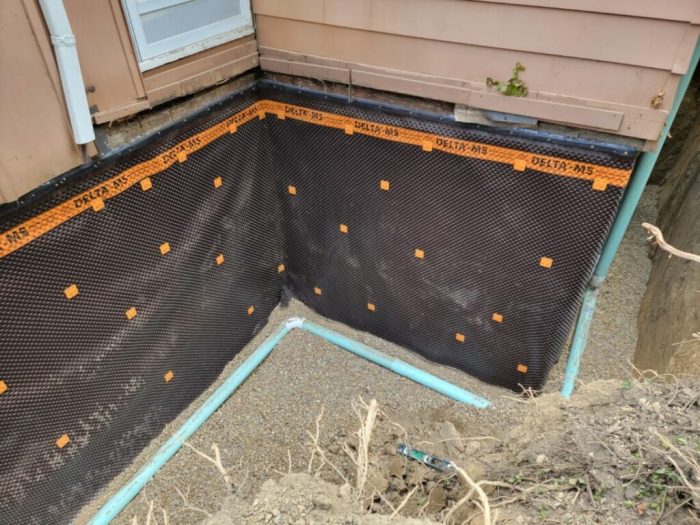
Source: pioneerbasementsolutions.com
Exterior waterproofing design is a crucial aspect of ensuring a building’s longevity and structural integrity. Careful consideration of various factors, from substrate preparation to environmental impacts, directly influences the effectiveness and durability of the waterproofing system. Proper design minimizes the risk of water damage, mold growth, and structural issues.
Effective waterproofing hinges on a meticulous design process that accounts for numerous elements. The design phase is not simply about choosing materials; it involves a comprehensive understanding of the interplay between building type, climate, drainage, and substrate characteristics. This understanding ensures the long-term protection of the structure.
Key Design Elements
Careful consideration of key design elements is fundamental to the success of any exterior waterproofing project. These elements encompass the structural specifics of the building and the interactions between the waterproofing system and the environment. These details include proper material selection, installation techniques, and adherence to building codes.
Importance of Proper Drainage and Ventilation
Adequate drainage and ventilation are critical for preventing water accumulation and promoting the drying of any moisture that penetrates the exterior. Poor drainage can lead to water pooling around the building foundation, potentially causing significant damage. Similarly, insufficient ventilation can trap moisture within the wall cavity, increasing the risk of mold and rot. A properly designed drainage system, often incorporating gutters and downspouts, directs water away from the building foundation. Sufficient ventilation, achieved through strategic openings and cavity design, facilitates drying and prevents moisture buildup.
Role of Substrate Preparation and Surface Treatments
Thorough substrate preparation and surface treatments are fundamental to achieving a waterproof exterior. The condition of the existing surface significantly impacts the adherence and longevity of the waterproofing membrane. Preparing the substrate involves removing loose debris, patching cracks and holes, and ensuring a smooth, even surface. Surface treatments, such as priming or sealing, enhance the adhesion of the waterproofing materials, thereby improving the system’s overall performance. Proper substrate preparation ensures that the waterproofing system adheres securely, preventing leaks and extending its lifespan.
Impact of Climate and Environmental Factors
Climate and environmental factors significantly influence the design and selection of exterior waterproofing systems. The intensity and frequency of rainfall, snow, and freezing temperatures, along with the presence of harsh chemicals or pollutants in the air, can affect the performance of waterproofing materials. In regions with high humidity, special considerations for moisture control are necessary. Building codes often incorporate specific requirements for different climate zones.
Examples of Different Building Types and Their Unique Waterproofing Challenges
Different building types present unique waterproofing challenges. For example, high-rise buildings often face the challenge of managing large volumes of rainwater runoff, while historical structures may require specialized techniques to accommodate existing materials and architectural features. Low-slung buildings, often with flat roofs, present challenges in preventing water from pooling and damaging the structure. Protecting the foundations of these buildings is vital. These different structural elements and conditions demand tailored design solutions.
Design Considerations Table, Exterior waterproofing
| Building Type | Design Considerations | Waterproofing Materials | Maintenance Needs |
|---|---|---|---|
| Residential Homes | Proper drainage around the foundation, roof slope considerations, and appropriate flashing around windows and doors. | Elastomeric coatings, modified bitumen membranes, and sheet membranes. | Regular inspection of flashing, gutters, and downspouts; periodic recoating of elastomeric coatings. |
| Commercial Buildings | Large-scale drainage systems, consideration of rooftop water management, and detailed specifications for high-traffic areas. | Modified bitumen membranes, liquid waterproofing systems, and specialized coatings. | Frequent inspections and maintenance of the drainage systems, roof surfaces, and potentially specialized cleaning. |
| Industrial Structures | Protection from harsh chemicals and environmental elements, substantial drainage, and durable materials to withstand heavy use. | Chemical-resistant membranes, reinforced coatings, and concrete waterproofing solutions. | Regular inspections for damage from chemicals and possible corrosion, along with specialized cleaning and repairs. |
Maintenance and Repair
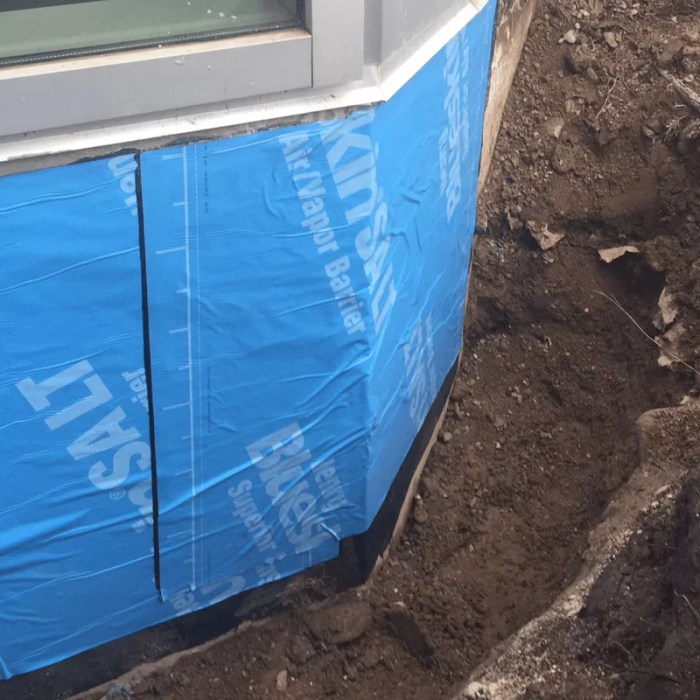
Source: foundationsfirst.ca
Exterior waterproofing systems, while designed to be long-lasting, require ongoing maintenance and occasional repairs to ensure their effectiveness. Proper maintenance minimizes the risk of costly damage and extends the lifespan of the entire structure. A proactive approach to inspection and repair is key to preventing significant issues.
Regular upkeep and prompt responses to minor problems can prevent major leaks and structural damage. Consistent monitoring and timely repairs can save substantial money in the long run. Understanding the common issues and how to address them is crucial for successful exterior waterproofing maintenance.
Proper Exterior Waterproofing Maintenance
Maintaining exterior waterproofing involves a multifaceted approach encompassing regular inspections, prompt responses to potential issues, and adherence to manufacturer recommendations. This proactive strategy ensures the system’s longevity and prevents costly repairs down the road. A comprehensive maintenance plan includes cleaning, checking for damage, and addressing any issues immediately.
Methods for Inspecting and Monitoring the System
Regular visual inspections are essential for identifying potential problems early on. These inspections should encompass the entire system, including the waterproofing membrane, flashings, and drainage components. Thorough documentation of findings is critical for tracking the system’s condition over time. Employing specialized tools, such as moisture meters, can enhance the accuracy and efficiency of the inspection process. Professional inspections by qualified technicians are recommended at least annually.
Procedures for Repairing Common Waterproofing Issues
Repairing exterior waterproofing issues often involves a multi-step process tailored to the specific problem. A critical step involves identifying the root cause of the problem. Common repairs include replacing damaged membranes, resealing joints, and addressing drainage issues. The selection of repair materials and methods should align with the specific waterproofing system used. Proper application techniques are crucial to ensure a durable and effective repair.
Table of Common Waterproofing Problems and Their Solutions
| Problem | Cause | Solution | Prevention |
|---|---|---|---|
| Cracked or Punctured Membrane | Impact damage, aging, and improper installation | Patching with compatible material, full replacement of a damaged section | Regular inspections, proper handling during construction, and using high-quality materials |
| Water Penetration at Flashing | Improper flashing installation, movement of building materials | Resealing and re-flashing, adjusting flashing to accommodate movement | Precise flashing installation techniques, using flexible flashing materials, and checking for building movement |
| Standing Water Around Foundation | Blocked or insufficient drainage, improper grading | Clearing obstructions, adjusting grading, and installing additional drainage systems | Careful grading around the foundation, ensuring proper drainage slopes, and regular inspection of drainage systems |
| Efflorescence | Moisture wicking through the walls, capillary action | Repairing the source of moisture intrusion, applying sealant to affected areas | Proper moisture barrier, appropriate waterproofing materials, and ensuring consistent ventilation |
Concluding Remarks: Exterior Waterproofing
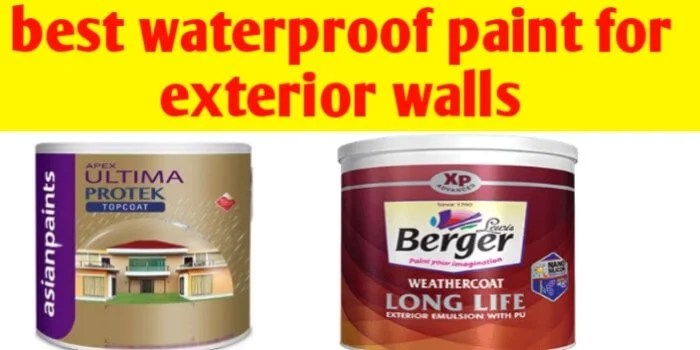
Source: civilsir.com
In conclusion, exterior waterproofing is a multifaceted process requiring careful consideration of materials, methods, and design principles. This comprehensive guide has provided a thorough overview, highlighting the importance of proper installation and maintenance for preventing costly repairs and ensuring the structural integrity of buildings. By understanding the different materials, techniques, and design elements, you’ll be equipped to make informed decisions about waterproofing your structures effectively.
